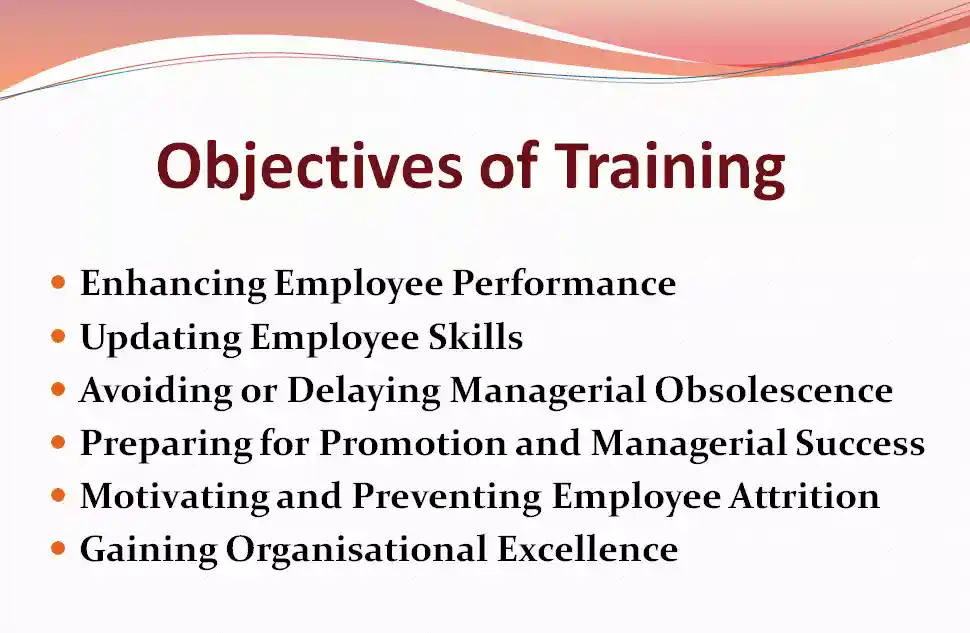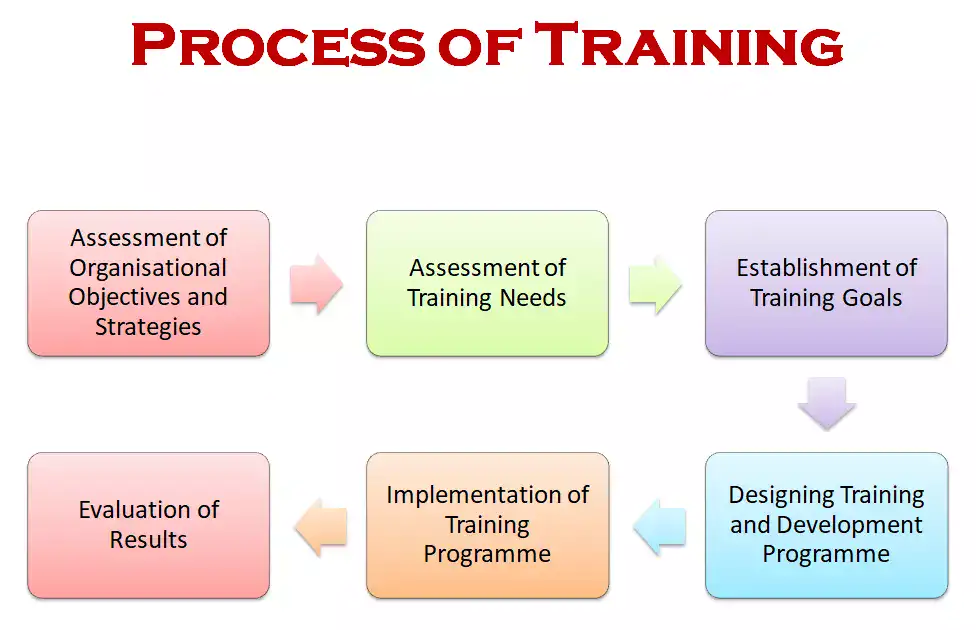Table of Contents:-
- Meaning of Training
- Definition of Training
- Objectives of Training
- Process of Training
- Limitations of Training
Meaning of Training
Training is a specialised and fundamental operative function of human resource management. It is a short-term process that utilises a systematic and organised procedure by which non-managerial personnel develop technical knowledge and skills for a definite purpose.
Training is a process of acquiring a sequence of programmed behaviours through learning. It is the application of knowledge and gives people an awareness of rules and procedures to guide their behaviour. It helps in bringing about a positive charge in the knowledge, skills, and attitude of employees towards the requirements of the job and organization. Thus, it bridges the differences between job requirements and employee’s present specifications.
Definition of Training
According to H. John Bernardin, “Training is any attempt to improve employee performance on a currently held job or one related to it”.
According to Dale S. Beach, “Training is the organised procedure by which people learn knowledge and/or skill for a definite purpose”.
According to Planty, Cord and Efferson, “Training is the continuous, systematic development among all levels of employees of that knowledge and their skills and attitude which contribute to their welfare and that of the company”.
According to Edwin B. Flippo, “Training is an act of increasing the knowledge and skills of an employee for doing a particular job”.
Objectives of Training
Objectives of training are as follows:

1) Enhancing Employee Performance
Imparting new skills helps in the performance enhancement of the employees assigned specific tasks. Training helps to bridge the gap between actual performance and the expected performance of an employee.
2) Updating Employee Skills
In the changing environment, technological changes are taking place at a faster rate. Organisations must keep track of the speed and direction of changes. It is the organizational and moral responsibility of management to ensure that employees are equipped with the knowledge and skills required to adapt to technological changes. Training systems encourage employees to update their abilities and integrate technological changes successfully into organisational strategies and procedures.
3) Avoiding or Delaying Managerial Obsolescence
A manager’s inability to cope with technological advancements is referred to as managerial obsolescence; it is the management’s failure to adopt new processes and methods. The obsolescence, in turn, retards organisational pe formance. Therefore, training is aimed at avoiding managerial obsolescence.
4) Preparing for Promotion and Managerial Success:
An employee acquires new skills in a training programme, and so can a manager. He/she takes on challenging tasks and does not hesitate to accept higher responsibilities. Training makes the transition of the employee from the present job to the next job faster, easier, and smoother.
5) Motivating and Preventing Employee Attrition
Employees need continuous development to move along the career path as per the career planning. Training motivates and reinstates organisational commitment. Managers must provide adequate training facilities to all employees, particularly to those who show promise.
6) Gaining Organisational Excellence
Skill, knowledge and motivation are the dominant determinants of human performance. A trained person requires less time and attention from the supervisor, as training enables them to be self-propelled. Thus, training substantially saves supervisors time. Training, additionally, reduces accident rates, break-down of machines and facilities, rejections and wastes, and enhances labour and material productivity. These factors improve organisational stability by creating a reservoir of a knowledgeable and skilled workforce who can help an organisation sustain its competitive edge and advantages.
Process of Training
The training process consists of various steps, which are shown in the image:

1) Assessment of Organisational Objectives and Strategies
The first step in an organisation’s training process is assessing its objectives and strategies.
- At what level of quality do an organisation wish to provide this product or service?
- What kind of business are we in?
- Where do we want to be in future?
It is only after answering these and other related questions that the organisation must assess the weaknesses and strengths of its human resources.
2) Assessment of Training Needs
Needs assessment diagnoses present problems and future challenges to be met through development and training. Organisations spend vast sums of money (usually as a percentage of turnover) on training and development. Before committing such huge resources, organisations should assess the training needs of their employees.
3) Establishment of Training Goals
Once training needs are set, training and development objectives must be specified. It is possible to design a training and development program with clearly defined plans. Moreover, after its implementation, there will be no way of measuring its effectiveness. Goals must be tangible, verifiable, and measurable. This is easy where skills training is concerned. For example, the successful trainee will be expected to type 60 words per minute with two or more errors per page. However, behavioural objectives like attitudinal changes can be more difficult to state. Nevertheless, clear behavioral standards and expected results are necessary so that the program can be effectively designed, and results can be evaluated.
4) Designing Training and Development Programme
The actual program design is the foundation for effective training and development. With relevant and trustworthy content, training and development efforts are worthwhile. The usual approach to content development starts with outlining programme content and then expanding that outline into fully formed programmes. Selecting the most appropriate instructors completes the process. Thus, several issues are involved in designing training programmes.
5) Implementation of Training Programme
Once the training programme has been prepared, it must be successfully implemented. Implementation is beset with certain problems. First, most managers are action-oriented and frequently say they are too busy to engage in training efforts. Secondly, the availability of trainers could be better. In addition to possessing communication skills, the trainers must know the company’s philosophy, objectives, formal and informal organisation, and the lines of the training programme. Training and development require a higher degree of creativity the moderate any other personnel speciality.
Programme implementation involves action along the following lines:
- i) Deciding the location and organising training and other facilities
- ii) Scheduling the training programme.
- iii) Conducting the programme.
- iv) Monitoring the progress of trainees.
6) Evaluation of Results
The last stage in the training and development process is evaluating results. Given the substantial amount of money spent on training and development, it is essential to assess the effectiveness of the program. Evaluation helps to determine the outcomes of the training and development programme. In practice, however, organisations either ignore or lack skills for evaluation.
Limitations of Training
Limitations of training are as follows:
1) Increase in Responsibility
After training the responsibility on the shoulders of employees increases as they have to face tough targets. Since the training programme makes the trained employees responsible, the working time in organisations may also increase.
2) Increases Competition
Training also increases competition between organisations.
3) Time-Consuming
Training is a time-consuming activity, especially in the absence of a planned, formal training programme with a set of organised courses to meet the needs of specific skill sets.
4) Loss of Investment to the Organisation
Sometimes employees after being trained feel dissatisfied with their job, and switch over to another job. In this case, the organisation bears the loss of investment done on employees during the process of training.
5) Costly Affair
Training programmes are a costly affair so special care is needed when these programmes are drafted.
6) Restricts Job Switching
The disadvantage of training on the part of employees is that before giving training to the employees, the organisation asks the employees to sign the bond, which hinders the development of a skilled employee as he will not be able to switch over to another job prospect with an increased salary.
7) Creates Feelings of Boredom
Repetition of work in an organisation creates the feeling of boredom among employees.
8) Sometimes Leads to Frustration
When an employee is trained specifically for a specific job he has to work on set patterns which creates a disciplined atmosphere in the organisation which sometimes frustrates employees, and thus, their morale decreases. Sometimes trained employees generally do not have someone there to motivate them when they feel sluggish.
9) Develops Feelings of Jealousy and Competition
Training also develops a feeling of competition and jealousy among employees when an employer praises an employee for his excellent work. It can be more clarified in a way that training does not develop the skills among employees at a similar rate as every individual’s ability, talents and skills vary with each other.
10) Natural Skills of Employees Remains Unexplored
Another disadvantage of training is that it is given for a specific purpose due to which other areas of employees’ skill remain unexplored and hence some employees do not get chance to develop their natural skills which may be productive to the organisation.
